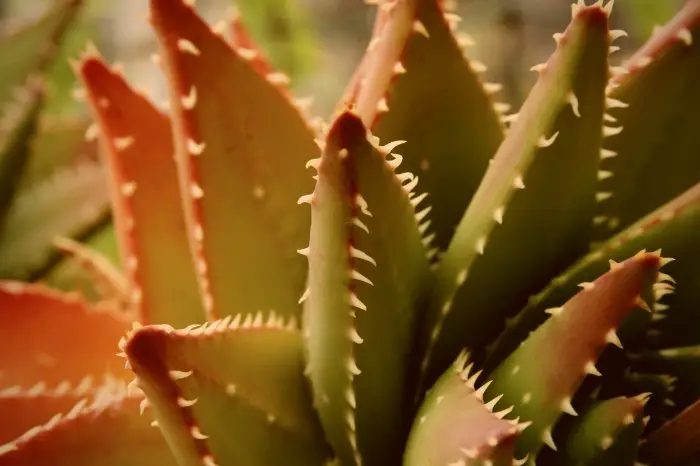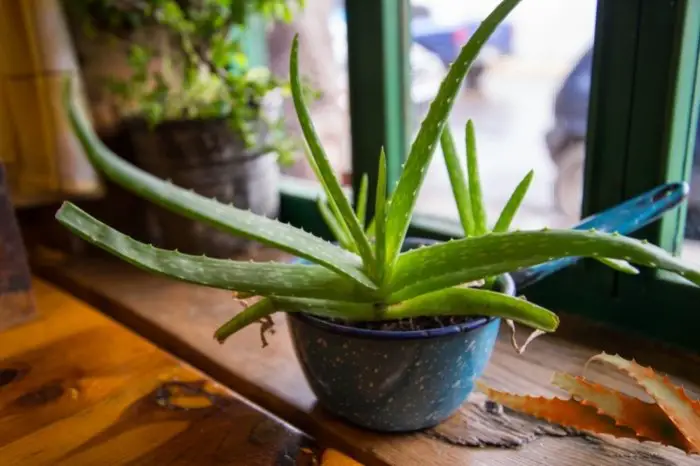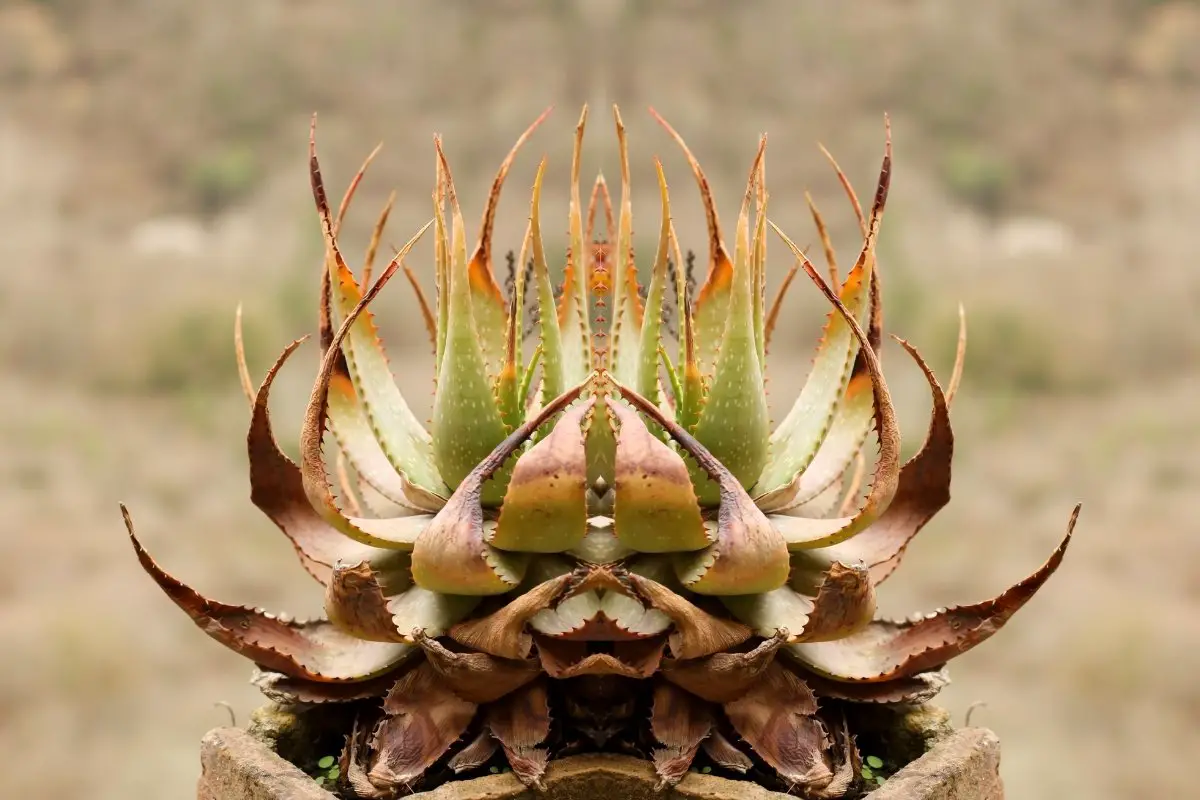Last Updated on April 25, 2022 by Fabiola L.
It is common to see sunburnt aloe vera plants where they have been left out under too much sun for a long time.
Aloe vera plants are generally grown outdoors in the USDA hardiness zones 9 through 12. Although they are simple plants to care for, they can be sensitive to sudden temperature changes leading to the browning of their leaves.
If you give your aloe vera plant too much sun for a long time, its leaves might get scorched, causing them to droop.
Let’s look at sunburnt aloe vera plants’ symptoms and how to revive them.
Sunburnt Aloe Vera Plants Symptoms
Some signs can tell if your aloe vera plant is getting too much sunlight. They include:
- Dry soil
- Yellow foliage
- Brown leaves
- Leaf sports
- Browning of the leaf tips

Can An Aloe Plant Recover From Sunburn?
Yes, the aloe vera plant can recover from sunburn naturally by providing lesser direct bright light and a little more watering. It may lose some foliage, but overall the aloe vera plant will recover from the sunburns.
If you’re growing your aloe vera plant outdoors, scorching summer is likely to damage it. Brown leaves are noticeable on the tips of the aloe vera plant spreading to the rest of the leaf. Reviving this plant is possible, but you will need to take intentional steps.
Once you realize your plant has suffered sunburn from excess exposure to sunlight, you can save it from dying and revive it.
Remove the plant from direct exposure to the sun immediately. Place it on top of a table in the middle of a room or at any shaded place for a while. Give it enough time until you see it begin to revive.
Give your plants a good shower because excessive sunlight tends to dry them up. Usually, succulents do not require much water, but a good shower helps revive them from extreme sunburn in this state.
Check Out How Often Should I Water Aloe Vera?
Should I Remove Brown Aloe Leaves From The Plant?
There are two ways to approach the Browning of your aloe leaves
One way to handle this is to trim off the tips of your aloe leaves that have turned reddish-brown. These tips are dying anyway, so it helps the plant to remain alive if you prune them. You can use a knife to prune small to medium-sized plants. Or use sharp shears for larger plants.

Another way you can handle the browning of leaves is by trying to revive the whole plant. To do this, clean all the soil from the roots and put the aloe plant roots in a glass or a water container. Use distilled water and stay in it for 2 to 3 days. After 3 days, you will notice some of the brown leaves beginning to get back to the green color.
This is the best time to repot a plant in a location that does not receive direct sunlight. At this point, your plant is recovered, but you will need to keep the soil moist enough and continue to water it as usual. It will take at least 2 to 3 weeks for the brown leaves to turn back to the green color. Not that not only leaves me to recover, but at least you can save the plants and some of their leaves.
Read more about Repotting Aloe Vera With Long Stem – A Quick Guide
Struggling Sunburnt Aloe Vera Plants After Recovery
After you have removed your plant from direct sun exposure and have kept it in a shaded area, it is possible to see your plants struggle.
Underwatering is one of the problems that cause your aloe vera to dry out and eventually die. Watch out to see if your plant is mushy and brown, as this is a clear sign that it is low on moisture.
Ensure that you do not damage the plants with over-watering is it can cause the plant’s roots to rot. In that case, your plant will turn brown, droop, and eventually, die.
Why Is My Aloe Vera Going Brown?
The stems of your aloe plant are likely to turn brown and mushy from too much water. However, several reasons cause your aloe vera plant to turn brown.
Costa Farms Aloe Vera Live Indoor Plant Ships in Grow Pot, 10-Inch Tall, Green
Improper Light
Aloe vera drives when grown in bright indirect sunlight. If placed in direct sunlight, it tends to get sunburned, and if placed in very low light, the leaves will droop downward.
Too Much Moisture
Your aloe plant love’s dry climate and is extremely drought resistant. The most common cause of browning and yellowing stalks is soil moisture. Water your aloe vera plant when 75% of your soil is dry, so stop during winter; you can allow your plants to dry out a little more in between waterings. When you water your aloe plant, provide it with enough water to the point where it flows from the drainage holes at the bottom of the pot. It is imperative to discard any excess watering from the saucer and not let your plant seat in any stagnant water. Aloe vera plant does not like wet roots as they cause root rot leading to the plant’s eventual death.
Some Yellowing Or Browning Is Natural
Old aloe vera leaves tend to get a yellow or brown as they grow old and ready for shedding.
Read more about Aloe Too Much Sun Appearance – Here Is How A Severe Sunburned Aloe Plant Looks Like
How To Prevent Aloe Plants From Getting Sunburnt
It is critical to note that aloe vera can survive in drought conditions, but that doesn’t mean it is immune to the side effects of too much sun. If you’re a beginner in growing a rose, learning how to prevent this plant from sunburn can save you from the heartache of losing your plant.
The secret to preventing your aloe plant from sunburn is to allow it to build a stronger sun exposure slowly. This works by placing your plants under shade for 5 to 6 days then slowly introducing them to 2 to 3 hours of the morning sun. The hardening of your plant keeps it from the danger of sunburns.
Avoid the afternoon sun as much as you can but keep increasing your plants’ sun exposure every 2 to 3 weeks. If you notice your plant struggles to uptake more hours of direct sunlight, shield it by providing shade.
If you notice your aloe plant with symptoms like wilting away or browning leaves, it might have underlying causes other than sunburn. Low moisture levels could make your leaves appear mushier or brown than before.
One of the advantages of growing aloe vera is its resilient nature. This is the reason why it grows even in the harshest conditions. However, no matter how tolerant your plant is, learn not to overwater or underwater it. Your watering pattern should provide adequate water and be consistent throughout the growing process.
Conclusion
The aloe vera plant is one of the most resilient succulents to grow outdoors and indoors. It survives harsh conditions, including direct sunlight and infrequent watering, but there is a limit for that too.
The sunburnt aloe vera plant can be salvaged before it dies by following the steps we have talked about above.
Read more about How to Keep Your Snake Plant Sunburn Free?
Caroline is a gardener who loves to get down to the nitty–gritty of gardening. She proudly proclaims herself as a ‘dirt worshipper‘ and can often be found deep in the garden, covered in soil and singing to her plants. As a self–proclaimed ‘plant whisperer‘, Caroline believes that plants need love and attention just like any other living thing, and she loves to give them both. When she‘s not tending to her garden, you can often find her researching the latest gardening trends, or teaching others how to make their gardens thrive



